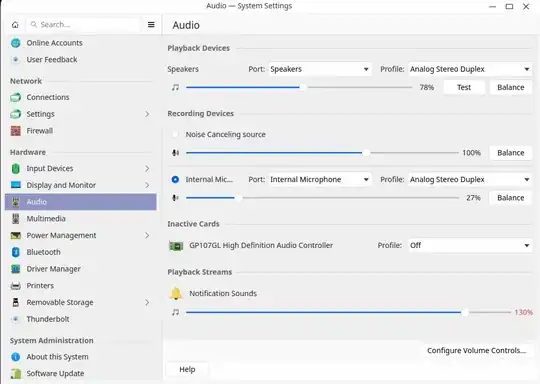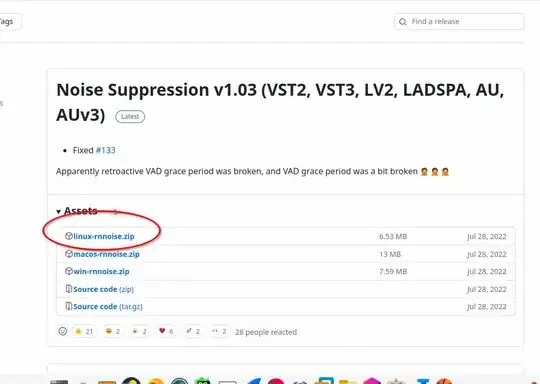I am trying to setup noise cacellation with pipewire on my laptop. I need the noise cancellation because I am recording myself for scholarship purposes.
I found this article below. @joelostblom posted instruction how to setup on pipewire:
Its not working for me. The sound driver is disable.
Here is the code inside my pipewire.conf file:
context.modules = [
#{ name = <module-name>
# [ args = { <key> = <value> ... } ]
# [ flags = [ [ ifexists ] [ nofail ] ]
#}
#
# Loads a module with the given parameters.
# If ifexists is given, the module is ignored when it is not found.
# If nofail is given, module initialization failures are ignored.
#
# Uses realtime scheduling to boost the audio thread priorities. This uses
# RTKit if the user doesn't have permission to use regular realtime
# scheduling.
{ name = libpipewire-module-echo-cancel
args = {
# library.name = aec/libspa-aec-webrtc
# node.latency = 1024/48000
source.props = {
node.name = "Echo Cancellation Source"
}
sink.props = {
node.name = "Echo Cancellation Sink"
}
}
}
{ name = libpipewire-module-rt
args = {
nice.level = -11
#rt.prio = 88
#rt.time.soft = -1
#rt.time.hard = -1
}
flags = [ ifexists nofail ]
}
# The native communication protocol.
{ name = libpipewire-module-protocol-native }
# The profile module. Allows application to access profiler
# and performance data. It provides an interface that is used
# by pw-top and pw-profiler.
{ name = libpipewire-module-profiler }
# Allows applications to create metadata objects. It creates
# a factory for Metadata objects.
{ name = libpipewire-module-metadata }
# Creates a factory for making devices that run in the
# context of the PipeWire server.
{ name = libpipewire-module-spa-device-factory }
# Creates a factory for making nodes that run in the
# context of the PipeWire server.
{ name = libpipewire-module-spa-node-factory }
# Allows creating nodes that run in the context of the
# client. Is used by all clients that want to provide
# data to PipeWire.
{ name = libpipewire-module-client-node }
# Allows creating devices that run in the context of the
# client. Is used by the session manager.
{ name = libpipewire-module-client-device }
# The portal module monitors the PID of the portal process
# and tags connections with the same PID as portal
# connections.
{ name = libpipewire-module-portal
flags = [ ifexists nofail ]
}
# The access module can perform access checks and block
# new clients.
{ name = libpipewire-module-access
args = {
# access.allowed to list an array of paths of allowed
# apps.
#access.allowed = [
# /usr/bin/pipewire-media-session
#]
# An array of rejected paths.
#access.rejected = [ ]
# An array of paths with restricted access.
#access.restricted = [ ]
# Anything not in the above lists gets assigned the
# access.force permission.
#access.force = flatpak
}
}
# Makes a factory for wrapping nodes in an adapter with a
# converter and resampler.
{ name = libpipewire-module-adapter }
# Makes a factory for creating links between ports.
{ name = libpipewire-module-link-factory }
# Provides factories to make session manager objects.
{ name = libpipewire-module-session-manager }
# Use libcanberra to play X11 Bell
{ name = libpipewire-module-x11-bell
args = {
#sink.name = ""
#sample.name = "bell-window-system"
#x11.display = null
#x11.xauthority = null
}
flags = [ ifexists nofail ]
}
]

